Media | Articles
60 years on, the Mercedes SL “Pagoda” remains a masterclass in car design
Editor’s note: Adrian Clarke is a professional car designer, having graduated in automotive design from Coventry University and achieving a Masters in Vehicle Design from the Royal College of Art in London. Tutored by the likes of J Mays, Clarke worked at a major European car maker before the pandemic knocked the world into a cocked hat. He now writes about design for Hagerty Media. Here he analyses the W113-generation SL “Pagoda,” in the year of its 60th anniversary.
Let’s try the car enthusiast’s version of a mindfulness exercise for a moment. Close your eyes, and take a moment to imagine the quintessential Mercedes-Benz. I’ve got a crisp bank note, denomination of your choosing, that says the car you were picturing was constructed of mostly straight lines combining to construct a logically solid, yet elegant and restrained-looking car; nothing like a current Benz. The man most associated with this Germanic aesthetic was Italian, the legendary Bruno Sacco, who headed the Sindelfingen studio from 1975 until 1999. But like a lot of great designers, he was the refiner not the instigator. It was his predecessor who first moved Mercedes away from pontons and gullwings at the beginning of the Sixties.
Paul Bracq, who would later make his name at BMW, studied under his countryman, French industrial designer Phillippe Charbonneaux. Like the American Raymond Loewy, Charbonneaux was true design polymath, both men leaving an indelible mid-century mark on their respective homelands. Bracq only worked for Charbonneaux for two years before having to complete his French national service. Recognizing a young talent, when he returned in 1957 he was offered a job in the design office at Mercedes.
The Mercedes image towards the end of the Fifties was one of rounded solidity. Above a range of indeterminate bulbous saloons sat the 300SL, recently can-opened into a roadster to prolong its shelf life, at the demand of Max Hoffman, Mercedes’ importer in America. Fearsomely expensive, it was essentially a race car for the road. Underneath it sat the similar looking, but rolling on four cylinder saloon undercarriage 190SL.
Mercedes was well aware the 190 was not a performer, so in time-honored tradition in 1957 engineers bolted an injected six into it and threw it swing axles et al, around the Nürburgring. It was nearly 25 seconds faster than the standard car, but technical difficulties and knowing such a model would be nearing the end of its life by the time it reached production put an end to the idea. The harsh reality was this pair of cars were too much and too little for the market. Now the time was approaching to replace them, and something to split the difference was needed.
Marketplace
Buy and sell classics with confidence
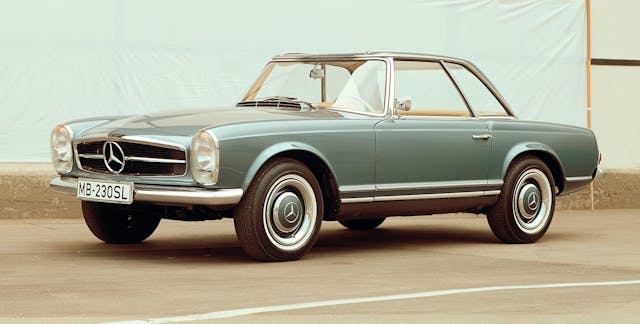
Around this time Mercedes was developing a new range of saloons—the W111 “Fintail”—that would introduce a revolutionary idea: a rigid passenger cell with deformable structures front and rear to absorb the energy from an accident. We call them crumple zones. It didn’t make commercial sense to use such an expensive, radical new platform for just one range of cars, so in 1960, Professor Fritz Nallinger, Mercedes’ Technical Director, suggested using it for a new sports car to replace both the 190 and 300SL. The man behind crumple zones was engineer Béla Barényi, who over the course of his career registered over two thousand patents for automotive safety. And his ideas would later give the new sports car one of its most distinctive features.
Mercedes had withdrawn from all motorsport following the Le Mans tragedy of 1955, so the new car was not beholden to any racing activity. It was free to be its own thing. And what Mercedes wanted was a mature car that reflected the brand’s prestige and solidity, with a newfound importance placed on safety.
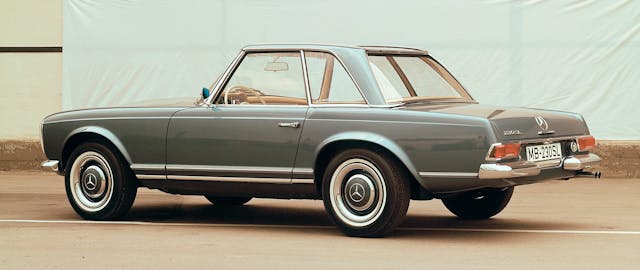
Introducing the car to the press at Chateau des Eaux Vives in Geneva 1963, Professor Nallinger said: “But now I may be permitted to explain the conception of our new 230SL model: It was our aim to create with this model a very safe, fast sports car with high performance which, despite its sports characteristics, has a very high degree of travelling comfort.”
The W113 230SL sat on a shortened W111 chassis with the 2.3-liter, straight-six-cylinder engine taken from the saloon, but with mechanical multipoint injection to move the power up the rev range. A four-speed manual was standard, but with Mercedes keeping an eye on its main export market of the United States, the new SL was offered with both a four-speed auto and power steering at extra cost.

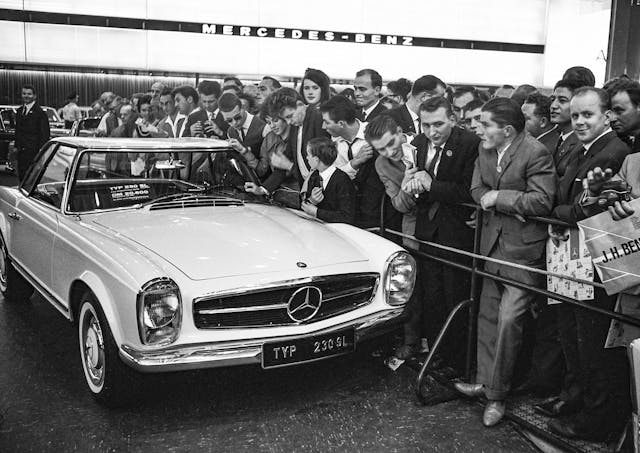
Pan-European road travel was still a possibility in those days. Depending on whether you were skiing or sunning the 230SL could be ordered as a convertible, a convertible with the hard top, or only the removable hard top (and no soft top underneath—confusing, I know). The distinctive concave shape of the hardtop, soon nicknamed “Pagoda” due to its resemblance to East Asian temples came about as a safety feature, again from the fertile mind of Barényi. He thought the highest point of the roof should be nearer the passengers heads rather than the middle, which gave the added benefit of larger side windows. Other safety features included split circuit front disc brakes, padded interior surfaces with no sharp corners, a collapsible steering column and, for the first time on a Mercedes, radial tires.
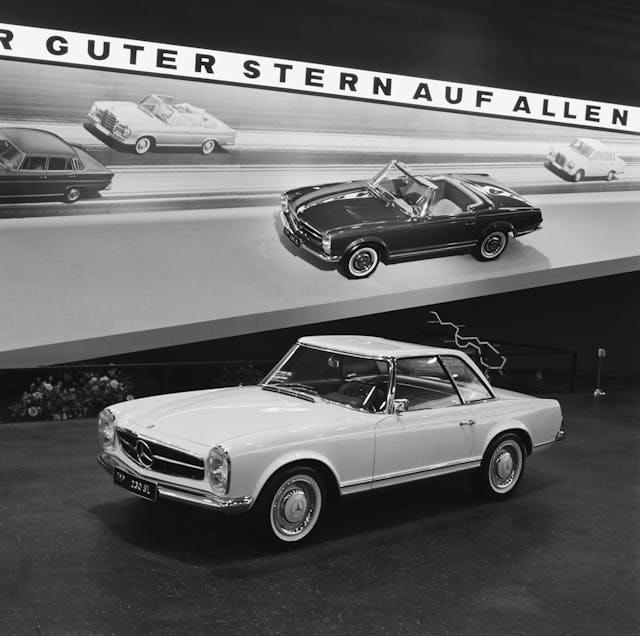
Although Unsafe at Any Speed, the campaigning book by Ralph Nader, wouldn’t be published until 1965, automotive safety was something conscientious manufacturers were designing into their cars. The Rover P6, although not a competitor, emerged the same year as the Pagoda and had standard seat belts, an ergonomic interior with break-away plastic switches and headlights that refracted a portion of light back towards the driver, allowing them to guide the car accurately in the dark.
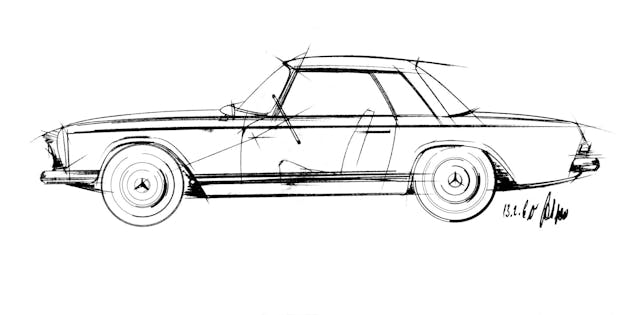
Dispensing with the upright, rounded stuffiness of the saloons, Bracq sketched a new sporting Mercedes that wasn’t beholden to the overt streamliner influences of the Gullwing. The Pagoda’s trick is looking substantial without appearing heavy. Mercedes’ reputation was built on quality of construction and thorough engineering. So although SL nominally stands for Super Lecht (Super Light), a gossamer, lightweight-looking car wouldn’t work for the brand image. It had to be something that exuded quality and usability.

The Pagoda manages this by limiting the depth of the bodyside, or at least appearing to. It’s a visual trick accomplished by painting the sills black, so they disappear. It makes the whole car sit lighter on its generous wheels. Although the headlights are vertical they sit lower than the bonnet which has a slight bulge because it hides a tall engine from a saloon; this tempers the formality of the lighting’s upright graphic.
It’s a supremely elegant confection of gently worked parallel lines that at first glance appear simple, but are extremely considered—there’s the merest hint of a hip just behind the door, and when viewed in profile there’s a subtle rake to the tail and a gentle taper towards the rear, giving an impression of movement and dynamism. When the hard top is in place it almost disappears thanks to the shallowness afforded by that concave shape and the generous glazing—a literal and metaphorical temple to lightness.
It’s a car for the discerning, those who valued quiet authority and getting there in comfort and style, as opposed to arriving first. The thrusting symbolism of an E-Type meant it found favor with villains and wide boys. The flashiness of a Corvette was for astronauts. Although both would have been a lot cheaper and given more performance, they were an altogether noisier, rowdier experience. The 911, which was still a few months off, was going to be a much more expensive, exotic, and treacherous proposition.
The beauty of the Pagoda is not just in its perfect lines and proportions. It was a practical, easy to drive, ergonomic, and safe sporting car when such a thing was a novelty. It spoke to Mercedes’ depth of engineering and the thoughtfulness it put into design when the norm was to take a powerful engine, clothe it as tightly as possible, and make everything else secondary.
Bracq’s formula with the Pagoda was tweaked to be slightly more upright and formal for the next generation of saloons, starting with the W108 of 1965, which essentially set the Mercedes design language for the next thirty or so years, proving the inherent rightness of the original. When Bruno Sacco took over as head of design in 1975, he was acutely aware that because of a Mercedes’ longevity, there was a need for continuity of appearance between generations of models. He favored careful evolution taking into account advances in safety and aerodynamics, and successfully transposed Bracq’s themes from the Pagoda to further SL models and saloons of all sizes until the W220 S-Class of 1998, his final car.
The Pagoda’s appeal might be its timeless styling and its impeccable build quality, but its real legacy is that it was the genesis of what could be considered the journey to “peak Mercedes.” The quintessential Mercedes qualities were already in place, but the Pagoda gave them a form and identity that came to exemplify Gottlieb Daimler’s founding philosophy of “the best or nothing.”
***
Check out the Hagerty Media homepage so you don’t miss a single story, or better yet, bookmark it. To get our best stories delivered right to your inbox, subscribe to our newsletters.
Via Hagerty UK


















I worked on lots of these back in the day. My favorite was the early 230 models with, strangely enough, the automatic transmission. The smaller engine revved more freely than the later 250 and 280 motors, and the automatic could grab the next gear much more quickly than a driver could manage with the four speed manual transmission, keeping the engine on the boil in the process. Lots of fun and a nice touring car to boot!
Long on looks, but short on rollover protection.
Such a classic beautiful car.
Again… Your comment is awaiting moderation.
I have always been a fan of the 230SL. Great car, great-looking car, but never seemed to outrun its reputation as “the doctor’s wife’s runabout”.
Had a 230, should have kept it, however it would be on a long list of other cars I wished I have kept. Very solid smooth car. Style you never get tired of
I remember in the ’60s, the W113 SL was in the category of “the $5,000 sports car” which, in the US (as the author pointed out) included the E-Type, Sting Ray and 911. In contemporary comparison road tests of the four, the Mercedes would always come in last. The build quality would be noted, but it was simply much slower than the others in both handling and straight line acceleration. It is good that several decades later, it has come into its own in terms of appreciation.
I can figure out what villains are, but what do you mean by wide boys? Thank you.
I didn’t know either, so I checked my usual source: Urban Dictionary. One definition is: “Wide-Boy is a person who is able to obtain or make almost anything happen (usually by nefarious means).” Which kind of fits into the author’s statement, it seems.
I love these little cars. My dad, a WWII vet and Buick man, who was never a big fan of foreign cars, really liked these – probably the only foreign car he ever really liked. And, he always said they looked very solidly built.
I also had one of the last year production of the 280SL and because it was a four speed sold it three years ago
as my wife and I decided we were not agile enough in our 80’s to handle the shifting routine. We bought it as
a used car in 1974 with 22,000 miles on it and it had just over 70,000 miles on the odometer when we sold it.
I had a ’69 280SL, and after that, a’64 230SL. The latter was used up but the 280SL, a LHD purchased in London in 1979, had only 9,800 miles and was pristine. The IRS and I having disagreed about my proposed tax due in 1981, the car had to go. I’ve longed for one, since, and am looking now for a ’71. Woulda, shoulda, coulda.
I long for the days when these cars were stuck in the teens. They exuded quality and style in a way that felt expensive, but they weren’t. Today, reality has caught up with perception, with the best examples fetching 10x what they were in the 90s.
You have to give Mercedes kudos for building such a classic car.
If you look at the 1960 to 62 Plymouth Valiant you will see that same Pagoda roofline. A nearly flat roof with raised side edges for structural strength. Built several years before Mercedes. Of course the rest of the body is typical Mopar for the period, weird yet sleek.
Yes, I own a 61 and a 62 Valiant … Gary
Bought a new one 10/67, w/ deep regret, sold him 8/20 for 21 times purchase price.
Funny enough, I had this article up on my monitor when a co-worker walked past and exclaimed “Have you ever worked on one of those!?” to which I answered “No.” He went on to tell me about some kind of bedliner-coating on the rockers which does an excellent job of holding rust together. Oh well, just another reason I won’t be interested in owning one anytime soon.
Otherwise I would have simply relied upon my visual instincts which tell me the whole car looks like the chassis was pulled forward while the body stayed behind, e.g., zero front overhang, rear wheel intrudes on the passenger compartment (making for an awkward door cut), rear overhang far too long. And those would be the interesting points. Otherwise it’s as sexy as Mr. Drysdale’s secretary; Miss Jane. All of this before I get to the roof, which looks like a little boy wearing grandfather’s hat. Then you still have the tailights that look like they were taken from a boat trailer and the front/rear star emblems that are scaled for American pick up trucks 50 years into the future.
I shall pass.
Gee, and I was just thinking how handsome it was….